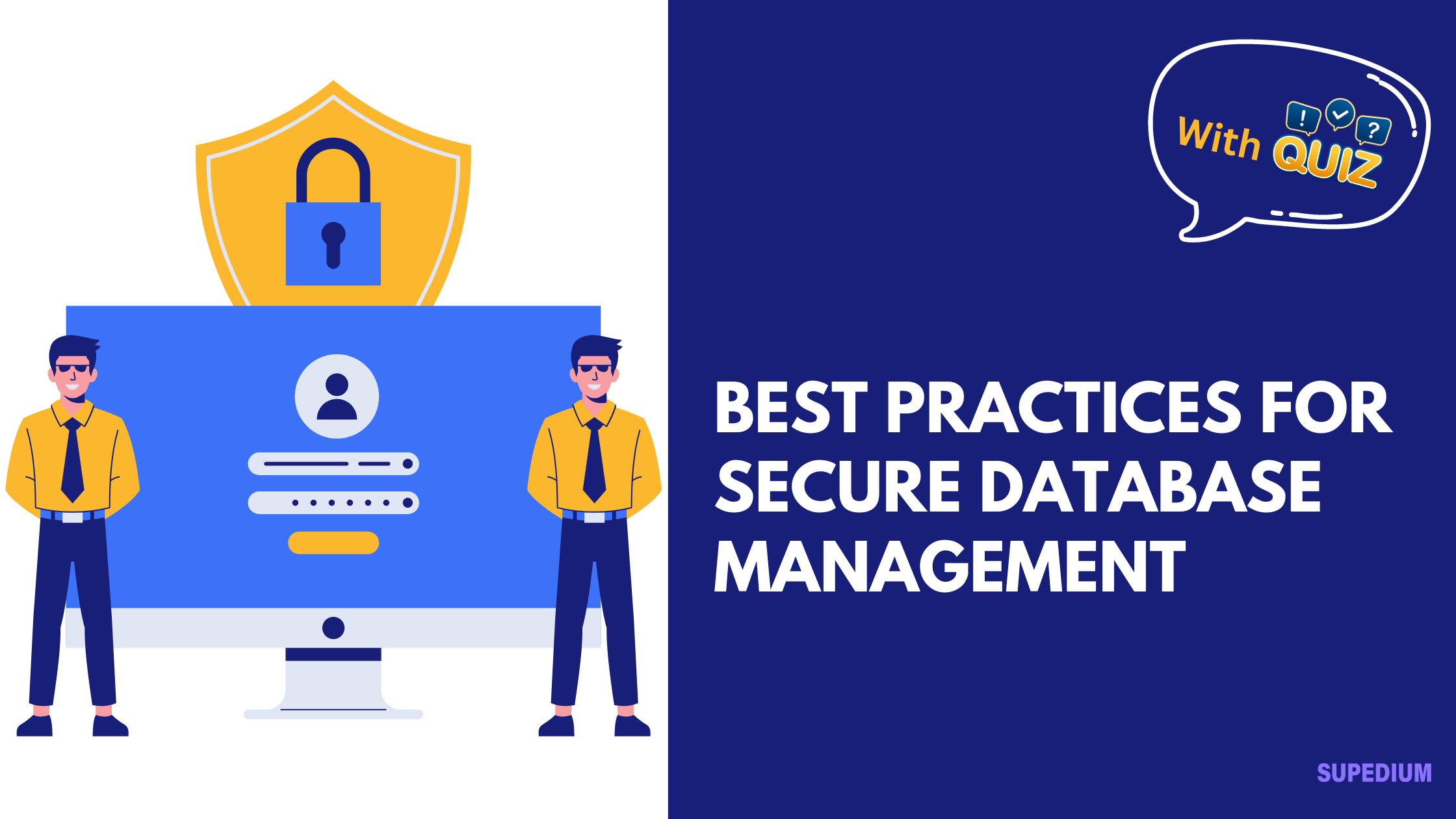Table of Contents
![]()
I. Introduction
In today’s digital landscape, database security has become a paramount concern for organizations of all sizes. With the increasing volume of sensitive data being stored and processed, the risk of data breaches has never been higher. A breach can lead to significant financial loss, reputational damage, and legal repercussions. This article aims to provide a comprehensive guide on best practices for secure database management, helping organizations protect their critical data assets.
II. Understanding Database Security
A. Definition of Database Security
Database security refers to the protective measures and controls implemented to secure a database from unauthorized access, breaches, and other cyber threats. This encompasses various strategies, technologies, and policies designed to safeguard data integrity, confidentiality, and availability.
B. Common Threats to Databases
- Unauthorized Access: Hackers often seek to gain access to databases to steal sensitive information. Weak credentials or poorly managed access controls can facilitate this.
- SQL Injection Attacks: This common attack method involves inserting malicious SQL code into queries, allowing attackers to manipulate or extract data.
- Data Breaches: Incidents where sensitive data is accessed or disclosed without authorization can lead to significant repercussions for organizations.
- Insider Threats: Employees with legitimate access to databases may inadvertently or maliciously compromise security.
C. Regulatory Compliance
Organizations must adhere to various regulations concerning data security, such as the General Data Protection Regulation (GDPR) and the Health Insurance Portability and Accountability Act (HIPAA). Compliance with these regulations is essential not only for legal reasons but also to build trust with customers and stakeholders.
III. Best Practices for Secure Database Management
A. Access Control
Implementing strict access controls is crucial for protecting sensitive data.
- Principle of Least Privilege: Grant users the minimum level of access necessary for their roles. This limits the potential for unauthorized actions.
- Role-Based Access Control (RBAC): Define roles within the organization and assign permissions based on these roles, ensuring users only have access relevant to their job functions.
- User Authentication and Password Policies: Utilize strong authentication mechanisms, such as multi-factor authentication (MFA), and enforce robust password policies.
B. Encryption
Encryption is a vital layer of security for protecting data.
- Data-at-Rest Encryption: Encrypt sensitive data stored on databases to prevent unauthorized access, even if physical security is compromised.
- Data-in-Transit Encryption: Use protocols such as TLS/SSL to encrypt data transmitted over networks, protecting it from interception.
- Key Management Strategies: Implement effective key management practices to safeguard encryption keys, ensuring they are stored securely and managed appropriately.
C. Regular Backups
Data loss can occur due to various reasons, including cyberattacks or hardware failures.
- Importance of Backup Strategies: Regularly back up database data to mitigate the risk of data loss and ensure business continuity.
- Secure Backup Storage Solutions: Store backups in secure, offsite locations, and ensure they are also encrypted.
- Testing Backup Restoration Processes: Regularly test the restoration of backups to ensure data can be recovered quickly and accurately when needed.
D. Network Security
Network security measures help protect databases from external threats.
- Firewalls and Intrusion Detection Systems: Use firewalls to monitor and control incoming and outgoing network traffic and implement intrusion detection systems to identify suspicious activities.
- Virtual Private Networks (VPNs): Secure remote access to databases using VPNs to encrypt data transmitted over public networks.
- Segmentation of Database Servers: Isolate database servers from other parts of the network to minimize exposure to attacks.
E. Monitoring and Auditing
Ongoing monitoring and auditing are essential for identifying and responding to security incidents.
- Database Activity Monitoring: Implement tools to monitor database activity in real time, detecting unusual behaviors that may indicate a breach.
- Audit Trails and Logging: Maintain comprehensive logs of database access and changes, which can help in investigations following a security incident.
- Regular Security Assessments and Vulnerability Scans: Conduct periodic assessments to identify and remediate vulnerabilities in database systems.
F. Software Updates and Patch Management
Keeping database software up to date is critical for security.
- Importance of Timely Updates: Regularly apply updates and patches provided by database vendors to fix known vulnerabilities.
- Automating Patch Management Processes: Utilize automated tools to streamline the patch management process, reducing the risk of oversight.
- Monitoring for Vulnerabilities in Database Software: Stay informed about vulnerabilities and threats affecting the specific database systems in use.
G. Secure Database Configuration
Properly configuring databases is essential to enhance security.
- Default Settings and Their Risks: Change default usernames, passwords, and configurations, which are often well-known to attackers.
- Hardening Databases Against Attacks: Follow security hardening guidelines specific to the database system to minimize the attack surface.
- Using Security Best Practices for Specific Database Systems: Tailor security measures to the specific databases in use, as different systems have unique vulnerabilities and configurations.
H. Incident Response Planning
Having a robust incident response plan can mitigate the impact of a security breach.
- Developing an Incident Response Plan: Create a detailed plan outlining the steps to take in the event of a security incident.
- Training and Awareness Programs: Regularly train staff on incident response procedures to ensure a quick and effective reaction.
- Post-Incident Analysis and Adjustments: After an incident, conduct a thorough review to identify weaknesses and improve future response efforts.
IV. Advanced Security Measures
A. Database Activity Monitoring Tools
Utilize specialized tools to continuously monitor database activities and detect potential threats in real time.
B. Anomaly Detection and Machine Learning
Employ machine learning algorithms to identify unusual patterns of behavior that may indicate a security breach.
C. Data Masking and Redaction Techniques
Use data masking to protect sensitive information in non-production environments, ensuring that developers and testers cannot access real data.
V. Training and Awareness
A. Staff Training Programs
Educating staff about database security is vital for fostering a secure environment.
- Importance of Security Awareness: Employees should understand the risks and their role in maintaining security.
- Regular Training Updates: Offer ongoing training sessions to keep staff informed about the latest threats and security practices.
B. Promoting a Security Culture
Creating a culture of security within the organization encourages vigilance and proactive measures.
- Encouraging Reporting of Suspicious Activity: Foster an environment where employees feel comfortable reporting potential security issues.
- Engaging Employees in Security Practices: Involve employees in security initiatives and discussions to promote a sense of ownership.
VI. Conclusion
In summary, securing a database is a multifaceted challenge that requires a proactive and comprehensive approach. By implementing best practices such as access control, encryption, regular backups, and continuous monitoring, organizations can significantly enhance their database security posture. As cyber threats evolve, ongoing vigilance and adaptation are essential to protect sensitive data and maintain regulatory compliance.






Be the first to comment